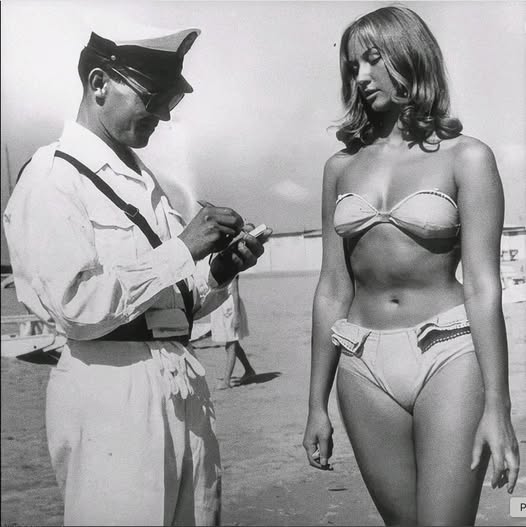At first glance, it seems like a harmless photo of a woman in a bikini on the beach. But look closer, and you’ll see the weight of history hidden in that carefree image—a history of controversy, rebellion, and cultural transformation. That small garment once provoked outrage, sparked bans, and led to arrests across the globe. Yet it also became a symbol of empowerment, challenging ideas of decency and reshaping how society views women’s bodies and freedom.
In the early 20th century, swimwear was all about modesty. Women wore heavy, neck-to-knee wool garments, and beaches across America enforced strict dress codes. Officials measured swimsuits for “compliance,” tailors were on hand to sew on extra fabric, and even bathing socks that revealed a woman’s knees were banned.
Change began to stir in 1907, when Australian swimmer Annette Kellerman wore a one-piece suit that revealed her arms, legs, and neck. Whether or not her reported arrest truly happened, her boldness made international headlines. She soon launched her own swimwear line, turning the act of swimming attire into a statement of choice.
The 1920s brought the flapper era, where women defied traditional roles, and beachwear followed suit. Movements like California’s “skirts be hanged” pushed for swimwear that allowed freedom of movement over enforced modesty. Practicality began to win over propriety.
But the real shock came in 1946. Louis Réard, a French engineer, unveiled the bikini—a two-piece that exposed the navel and more skin than ever before. He named it after Bikini Atoll, the site of a recent U.S. nuclear test, claiming its impact would be equally explosive. He was right. The bikini was banned in multiple countries, condemned by the Pope, and labeled immoral by conservative governments. Photos from the time show police confronting women on beaches, ticketing them, or escorting them away for “indecency.”
Through the 1950s and 60s, resistance continued. Hollywood’s Hays Code censored exposed navels, and morality groups fought the bikini’s spread. But cultural icons refused to yield—Marilyn Monroe’s playful poses, Brigitte Bardot’s sun-soaked glamour, and Ursula Andress’s iconic ocean scene in Dr. No transformed the bikini into a worldwide emblem of beauty, confidence, and power.
By the 1970s, what was once scandalous had become mainstream. Bikinis grew smaller, string styles emerged, and men’s swimwear also became more revealing. What began as an attempt to control women’s clothing had been reclaimed as a personal choice.
Today, the swimwear debate is no longer about morality but about self-expression. Whether it’s a full-coverage one-piece, a sporty rash guard, or the tiniest bikini, the meaning is the same: wear what makes you feel strong, comfortable, and yourself.
So when you see that woman on the beach, it may look like just another sunny day. But behind that image is a century-long struggle for the right to be seen, to be free, and to decide—without apology—what to wear.
